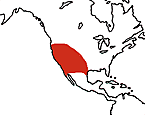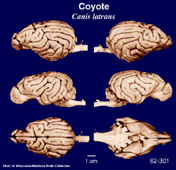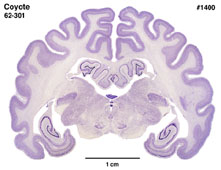|
Coyote
Canis latrans
Head and body length of C. latrans is 750-1,000 mm
and tail length is 300-400 mm. Males weigh 8-20 kg and are
usually larger than females who generally weigh from 7-18
kg. Individuals is the souther part of C. latrans range
tend to be smaller than those who live in the north. Pelage
varies, but is generally long and buffy gray with lighter
underparts. The tip of the tail is often black.
C. latrans is found in a variety of habitats including
open grasslands, brush country and broken forests. Coyotes
builld .3 meter wide dens approximately 1 meter below ground
which are reached by tunnels 1.5-7.5 meters long. They are
generally nocturnal and crepuscular, covering an average of
4 km while hunting. C. latrans can reach speeds of
up to 64 km/hr. The diet consists mainly of other mammals
including lagomorphs and rodents, but have also been observed
fishing in shallow water. Larger prey animals are usually
taken in the form of carrion, but some coyotes do work together
to bring down larger quarry. C. latrans may also form
a 'hunting partnership' with the badger. They move together,
the coyote using its keen sense of smell and the badger using
its powerful digging capabilities to find and kill burrowing
mammals. Both badger and coyote share their proceeds.
The availablilty of food and habitat have a direct impact
on the social structure of C. latrans. The territories
of males are rather large and tend to overlap, while that
of females is smaller and do not. Once a female has chosen
a partner from the several who may court her during mating
season, she and the male may stay together for many years.
Packs develop when the offspring of one pair remains with
the parents to help rear subsequent litters. Mating takes
place from January to March with births occuring in the spring.
Estrus is from 4-15 days with gestation lasting 58-65 days.
Litter sizes are between 2-12 offspring, averaging around
6 pups. Two females may share a den, resulting in apparently
very large litters. The pups weigh about 250 grams at birth.
They open their eyes at 14 days of age and emerge from the
den after 2-3 weeks.
C. latrans is found in Canada, Costa Rica, El Salvador,
Guatemala, Honduras, Mexico, Nicaragua, USA. Introduced to
Florida and Georgia and currently widespread throughout Northern
and Central America.
|



